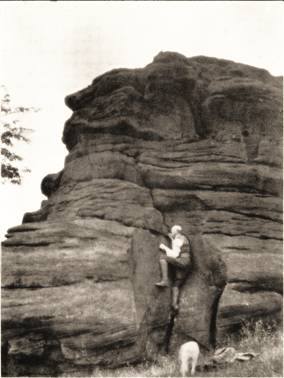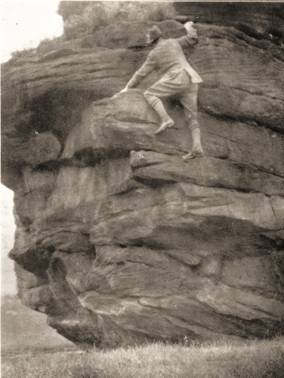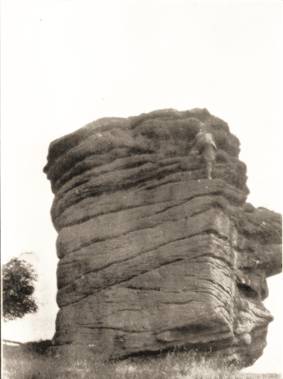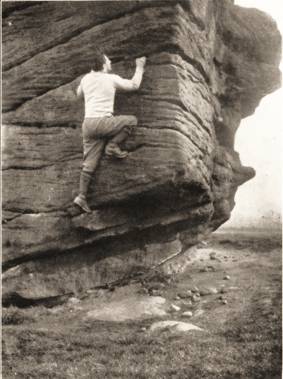A Spofforth Pinnacle
By “Columbus, Junior.”
“Christopher Columbus was a great sailor and wanted to discover America. So one day he went to the King and said: ‘O King, I want to discover America. Give me some ships.’ So the King gave him the ships and Columbus went and discovered America.”
This account, though generally regarded as a schoolboy howler, is nearer the truth than at first sight appears. Columbus was morally certain that there was land to the West to be discovered, though he was ignorant both of a its character and of the fact that it had been discovered already by Leif Ericson, the Norseman.
The Spofforth Pinnacles may probably be credited with being the most frequently discovered rocks in England. I write in England advisedly, because they manage things differently in Wales. I do not understand the methods of Cambrian climbers. First they discover a climb, sometimes, in fact, a rock-face four or five times as high as a steeple and as long as a street. Then they lose it. Then they discover it again. Then they find it is extremely difficult; then they discover it is really very easy. The next step, I suppose, will be for somebody to fall off. One of the latest achievements has been the discovery of a mighty rock-face that has been staring down Nant Francon ever since Adam was a schoolboy, and forms the most conspicuous object in sight for about a mile and a half of the way up to Ogwen.
It was in the spirit of Columbus I left Harrogate one morning with Leif Ericson. He had been there before. In fact it is a matter of dispute between himself and two other Ramblers as to which discovered the Spofforth Pinnacles first and, if so, most often.
For the information of future discoverers I may say that the Spofforth Pinnacles are situated on the left bank of the Crimple Beck to the north of Spofforth. From Spofforth Railway Station you walk through the village, leaving the pubs on the left and the Church on the right, turn to the right beyond the Church, then to the left, and so past Spofforth Mill. Beyond this you are affronted by a ridiculous notice as to right of way, which you regard or not, according to disposition the ‑ legal detour is only about fifty yards ‑ and there you are.
The first of the Torroni is something like an overgrown cask, about twenty feet high, with one of the sides stove in. The line of ascent is obvious, but neither quite easy nor pleasant. The chief difficulty is in getting out on sloping handholds with a bramble in your ear and a nettle on your nose. A tree is said to afford a feasible line of descent, but I mistrust it.
The next Pinnacle affords at least three sporting routes ‑ I think that is the correct phrase.
I. (Plate I.): Over the nose. This somewhat resembles the first part of the Inaccessible Pinnacle at Robin Hood’s Stride, though far less difficult, and is to be commended to skilled players at leapfrog.
2. (Plate I.): A stiffish little crack, with a stiffish pull out on to ledges, greasy and sloping to the climber’s disadvantage. The blur on the foreground of the photograph is caused by the tail of or belonging to the dog of or belonging to Leif
3. On the uphill face of the rock ‑ to the climber’s right as he faces it ‑ is a neat little face climb.
There are numerous other outcrops presenting courses of various interest. The next boulder solvitur saltando, if I remember rightly, you can jump on to the top with ease and nerve, and steady other people up any fancy routes with a rope, should they not scorn one. N.B.‑ It is easier to jump off than to jump on to this boulder, and it is comforting to know that the chances of bashing your shins are less than at the Laddow Pinnacle.
The next obvious bit of climbing has a wall in the middle of it, and the next, the bulkiest of all, is not inaccessible, though the way up takes a bit of finding.
Beyond this, close to the hedge running down below Braham Hall, is the pick of the boulders. There are two easy ways up (see Plate II), and one of the most difficult climbs of its inches in Yorkshire (Figs. 3 and 4). The commencement somewhat resembles the start of the Virgin Climb at Almscliff, but, as soon as this minor traverse is completed, the way lies straight up the corner and is much more severe than the finish of the Virgin.
The ascent of the next boulder, a few hundred yards nearer Plompton, is not quite so simple as it looks. To save unnecessary exertion I may say that the key to the crack on the Plompton side ‑ opposite a small excrescence of rock ‑ is a splendid right hand-hold inside the, crack, about ten feet up. The joy of this boulder, however, is a corkscrew traverse, beginning from an unmistakable little cave and working round the boulder, finishing above the cave. It is the first step that costs and the most delicate balance is required, albeit plenty of concentration is demanded elsewhere. The distance from the ground is not great but for the mair pairt of the time ye have a spike o’ rock in your wame, and the tendency is to fall backward. Wherefore, although the Ramblers have no suckers in their feet, they might do well to provide themselves with gutta-percha safeguards elsewhere. There is another and very severe corkscrew traverse on the Pinnacle previously described, off which you can fall further and fare worse.



